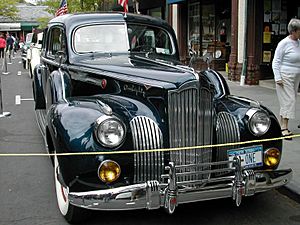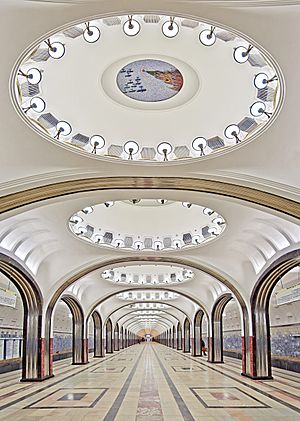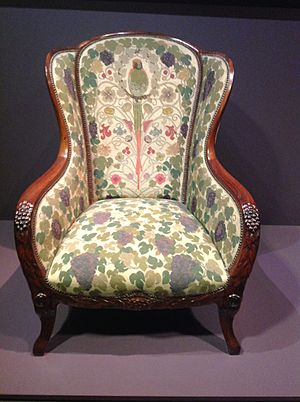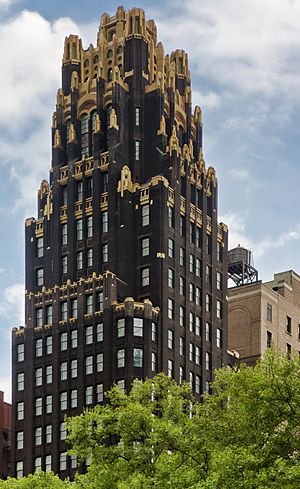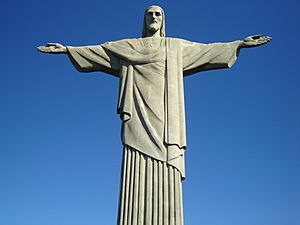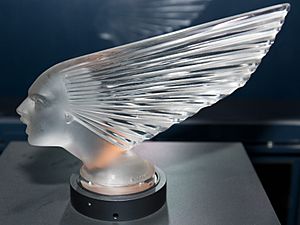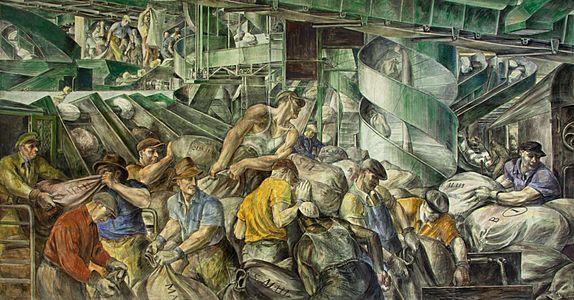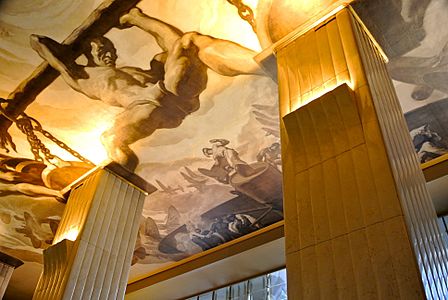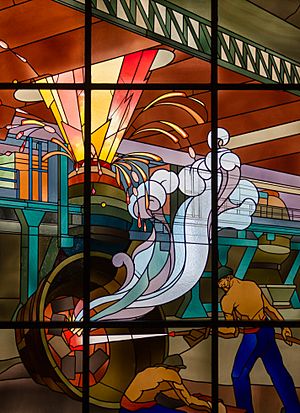Art Deco facts for kids

Art Deco is a cool and fancy style of decorative art, design, and architecture. It was popular in the 1920s and 1930s across Europe, the United States, and many other countries. The name "Art Deco" comes from a big international exhibition held in Paris in 1925. However, you can find some early examples even before the First World War. Before Art Deco, there was another style called Art Nouveau, which used more natural, plant-like shapes.
Art Deco was one of the first styles of modern architecture. It took ideas from different art movements of the early 1900s, like Neoclassical, Constructivism, Cubism, Modernism, and Futurism. Later Art Deco, especially in the mid to late 1930s, is sometimes called Streamline Moderne. This name comes from the idea of making buildings look smooth and fast, like a car designed for aerodynamics.
The Art Deco style was often used for big public buildings rather than just houses. Many banks, schools, and libraries were built this way. During the Great Depression, the Works Progress Administration built many public buildings in the Art Deco style to help people find jobs. American skyscrapers really showed off the Art Deco style. They became some of the tallest and most famous modern buildings in the world. Their height, shape, color, and bright lights at night were meant to show how important their builders were.
Contents
What Made Art Deco Special?
During its most popular time, Art Deco was all about luxury and glamour. It often used very expensive materials like ebony wood and ivory. The craftsmanship was also amazing. Nothing about Art Deco was cheap! For example, furniture pieces might have ivory and silver designs. Art Deco jewelry combined diamonds with platinum, jade, coral, and other precious materials.
This fancy style was used to decorate the first-class areas of huge ocean liners, fancy trains, and tall skyscrapers. It was also popular around the world for decorating the grand movie theaters of the late 1920s and 1930s. Later, after the Great Depression, the style became a bit simpler and less flashy.
Famous Art Deco Buildings
In New York City, many buildings from the 1920s and 1930s are great examples of Art Deco. Famous ones include the Chrysler Building in New York City and the Chicago Board of Trade Building in Chicago. Another well-known building is Bullock's Wilshire in Los Angeles. Many Art Deco buildings have detailed terra cotta (a type of baked clay) designs or murals inside them. Even the towers of the Golden Gate Bridge have an Art Deco look.
The insides of American Art Deco buildings were often very grand. This was especially true for the lobbies of government buildings, theaters, and office buildings. These interiors were super colorful and exciting! They mixed sculpture, murals, and fancy geometric patterns using marble, glass, ceramics, and stainless steel. Some examples are the Fisher Building and the Guardian Building in Detroit, and the 450 Sutter Street building in San Francisco.
In France, a great example of an Art Deco interior is the Palais de la Porte Dorée (1931).
Many of the best Art Deco buildings that still exist today are cinemas built in the 1920s and 1930s. This was when movies changed from silent films to movies with sound. Movie companies built huge, fancy theaters in big cities to attract the massive audiences who came to watch films.
Art Deco Sculpture
Sculpture was a really important part of Art Deco architecture. These sculptures usually showed heroic figures or symbols. In France, Antoine Bourdelle created sculptures of dance and music for the Théâtre des Champs-Élysées in Paris in 1912. This was one of the earliest Art Deco landmarks.
In the United States, Paul Manship was a very important Art Deco sculptor for public art. His most famous work is the statue of Prometheus at Rockefeller Center in New York City. Other important sculptures for Rockefeller Center were made by Lee Lawrie, including the Atlas statue.
During the Great Depression in the U.S., many sculptors were hired to create art for government buildings. These artists included Sidney Biehler Waugh, who made strong, ideal images of workers. In San Francisco, Ralph Stackpole created sculptures for the new San Francisco Stock Exchange building.
One of the most famous and largest public Art Deco sculptures is the Christ the Redeemer. This huge statue was made by the French sculptor Paul Landowski between 1922 and 1931. It stands on a mountain overlooking Rio de Janeiro, Brazil.
Small Sculptures for Homes
Many early Art Deco sculptures were small. They were made to decorate people's homes and fancy rooms.
One of the most famous sculptors for these smaller pieces was Demétre Chiparus, who was born in Romania. He made colorful small sculptures of dancers. Other notable sculptors included Ferdinand Preiss and Josef Lorenzl.
Art Deco Painting
-
Workers sorting the mail, a mural in the Ariel Rios Federal Building, Washington, D.C., by Reginald Marsh (1936)
-
Art in the Tropics, mural in the William Jefferson Clinton Federal Building, Washington, D.C., by Rockwell Kent (1938)
-
Detail of Time, ceiling mural in lobby of 30 Rockefeller Plaza in New York City, by Josep Maria Sert (1941)
Two painters are very well known for their Art Deco style: Jean Dupas and Tamara de Lempicka.
During the Great Depression, the Federal Art Project was created to help unemployed artists find work. Many artists were hired to decorate government buildings, hospitals, and schools with murals. Artists from many different styles worked on these murals. They included Reginald Marsh, Rockwell Kent, and the Mexican painter Diego Rivera.
Glass Art in Art Deco
Art Deco was a special time for beautiful glass art and other decorative items. These pieces were designed to fit perfectly with their surroundings. The most famous glass artist was René Lalique. His works, from vases to car hood ornaments, became symbols of the era. He started making glass art seriously after World War I. He bought a large glass factory and began making both artistic and useful glass objects. He treated glass like sculpture, creating statues, vases, bowls, lamps, and ornaments.
Lalique also made decorative glass panels, lights, and illuminated glass ceilings for famous ocean liners like the SS Île de France (1927) and the SS Normandie (1935). He also designed parts of fancy French trains.
Other important Art Deco glass makers included Marius-Ernest Sabino. He was known for figurines, vases, and glass sculptures of fish and animals. He often used a special glass that could change color from white to blue to amber depending on the light.
Sadly, the Great Depression hurt a lot of the decorative glass industry because it relied on wealthy customers.
Amiens Cathedral has a rare example of Art Deco stained glass windows. They are in the Chapel of the Sacred Heart and were made in 1932-34 by Jean Gaudin.
Images for kids
-
Niagara Mohawk Building, Syracuse, New York
-
Interior of the Théâtre des Champs-Élysées, with Bourdelle's bas-reliefs over the stage
-
The gilded bronze Prometheus at Rockefeller Center, New York City, N.Y., by Paul Manship (1934), a stylised Art Deco update of classical sculpture (1936)
-
Chrysler Building, New York City, by William Van Alen (1930)
-
Crown of the General Electric Building (also known as 570 Lexington Avenue), New York City, by Cross & Cross (1933)
-
30 Rockefeller Plaza, New York City, by Raymond Hood (1933)
-
Empire State Building, New York City, by Shreve, Lamb & Harmon (1931)
-
Lee Lawrie, 1936–37, Atlas statue, in front of the Rockefeller Center (installed 1937)
-
Los Angeles City Hall by John Parkinson, John C. Austin, and Albert C. Martin Sr. (1928)
-
Interior of the Palacio de Bellas Artes (Palace of Fine Arts) in Mexico City, Mexico (1934)
-
National Diet Building in Tokyo, Japan (1936)
-
Anzac Memorial in Sydney (1934)
-
Louisiana State Capitol in Baton Rouge, Louisiana, USA (1930–32)
-
Buffalo City Hall in Buffalo, New York, USA (1931)
-
The Bacardi Building in Havana, Cuba (1930)
-
Guardians of Traffic pylon on Hope Memorial Bridge in Cleveland (1932)
See also
 In Spanish: Art déco para niños
In Spanish: Art déco para niños


